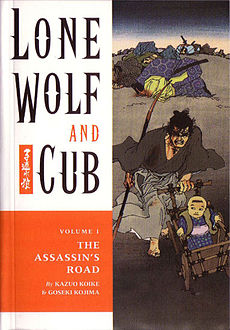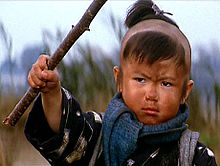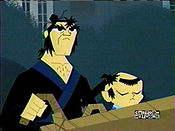- Lone Wolf and Cub
-
Lone Wolf and Cub 
Cover art by Frank Miller of Lone Wolf and Cub vol. 1 (English version)子連れ狼
(Kozure Ōkami)Genre Chanbara Manga Written by Kazuo Koike Illustrated by Goseki Kojima Published by Futabasha English publisher  Dark Horse Comics
Dark Horse ComicsDemographic Seinen Magazine Weekly Manga Action Original run September 1970 – April 1976 Volumes 28 Lone Wolf and Cub (子連れ狼 Kozure Ōkami) is a manga created by writer Kazuo Koike and artist Goseki Kojima. First published in 1970, the story was adapted into six films starring Tomisaburo Wakayama, four plays, a television series starring Yorozuya Kinnosuke, and is widely recognized as an important and influential work.
Lone Wolf and Cub chronicles the story of Ogami Ittō, the Shogun's executioner who uses a dōtanuki battle sword. Disgraced by false accusations from the Yagyū clan, he is forced to take the path of the assassin. Along with his three-year-old son, Daigorō, they seek revenge on the Yagyū clan and are known as "Lone Wolf and Cub".
Contents
Plot summary
Ogami Ittō, formidable warrior and a master of the suiō-ryū swordsmanship, serves as the Kogi Kaishakunin (the Shōgun's executioner), a position of high power in the Tokugawa Shogunate. Along with the oniwaban and the assassins, Ogami Ittō is responsible for enforcing the will of the Shogun over the daimyō (lesser domain lords). For those samurai and lords ordered to commit seppuku, the Kogi Kaishakunin assists their deaths by decapitating them to relieve the agony of disembowelment; in this role, he is entitled and empowered to wear the crest of the Shogunate, in effect acting in place of the Shogun.
After Ogami Ittō's wife Azami gives birth to their son, Daigorō, Ogami Ittō returns to find her and all of their household brutally murdered, with only the newborn Daigorō surviving. The supposed culprits are three former retainers of an abolished clan, avenging the execution of their lord by Ogami Ittō. However, the entire matter was planned by Ura-Yagyū (Shadow Yagyu) Yagyū Retsudō, leader of the Ura-Yagyū clan, in order to seize Ogami's post as part of a masterplan to control the three key positions of power: the spy system, the official assassins and the Shogunate Decapitator. During the initial incursion, an ihai (funeral tablet) with the shogun's crest on it was placed inside the Ogami family shrine, signifying a supposed wish for the shogun's death. When the tablet is "discovered" during the murder investigation, its presence condemns Ittō as a traitor and thus he is forced to forfeit his post.
The 1-year-old Daigorō is given a choice by his father: a ball or a sword. If Daigorō chose the ball, his father would kill him, sending him to be with his mother; however, the child crawls toward the sword and reaches for its hilt. This assigns him the path of a rōnin, wandering the country with his father as "demons"—the assassin-for-hire team that becomes known as Lone Wolf and Cub, vowing to destroy the Yagyū clan to avenge Azami's death and Ittō's disgrace.
On meifumadō ("The Road to Hell"), the cursed journey for vengeance, Ogami Ittō and Daigorō experience numerous adventures, encountering (and slaying) all of Yagyū Retsudō's children and the entire Kurokuwa ninja clan, and eventually facing Retsudō himself. The first duel between Ogami Ittō and Yagyū Retsudō runs 178 panels—one of the longest single fight-scenes ever published in comics.
Toward the end of their journeys, Ogami Ittō's dōtanuki sword is surreptitiously damaged by a supposed sword-polisher who is really an elite "Grass" ninja of the Yagyū clan. When attacked by the last of the "Grass" ninja, the sword breaks due to Yagyū tampering, and Ittō receives wounds that are ultimately fatal. Deadlocked in mid-battle with Retsudō, Ittō's spirit leaves his body after a lifetime of fatigue and bloodshed, unable to destroy his longtime enemy and ending his path of meifumadō.
The story finishes with Daigorō taking up Retsudō's spear and charging in fury. Retsudō opens his arms, disregarding all defense, and allows Daigorō to drive the spear into his body. Embracing Daigorō with tears, Yagyū Retsudō names him, "Grandson of my heart", closing the cycle of vengeance and hatred between the clans and concluding the epic.
Characters
- Ogami Ittō (拝 一刀)—The shogun's executioner, Ittō decides to avenge the death of his wife, Ogami Azami (拝 薊, "Asami" in the Dark Horse version) and to restore his clan.
- Ogami Daigorō (拝 大五郎 romanized as "Daigoro" in the Dark Horse version)—The son of Ittō and Azami, Daigorō becomes a stronger warrior as the story progresses.
- Yagyū Retsudō (柳生 烈堂)—The leader of the Yagyū clan, Retsudō tries everything in his power to ensure that Ittō dies.
- Abe Tanoshi (阿部 頼母, also known as Kaii (怪異))—The shogun's food taster, Tanoshi dishonorably tries to kill Ittō and Daigorō.
Media
Manga
When Lone Wolf and Cub was first released in Japan in 1970, it became wildly popular (some 8 million copies were sold in Japan) for its powerful, epic samurai story and its stark and gruesome depiction of violence during Tokugawa era Japan.
Lone Wolf and Cub is one of most highly regarded manga due to its epic scope, detailed historical accuracy, masterful artwork and nostalgic recollection of the bushido ethos. The story spans 28 volumes of manga, with over 300 pages each (totaling over 8,700 pages in all). Many of the frames of the series are hauntingly beautiful depictions of nature, historical locations in Japan and traditional activities done in the classical ukiyo-e style.
Lone Wolf and Cub was initially released in North America by First Comics in 1987, as a series of monthly, comic-book-sized, square-bound prestige-format black-and-white comics containing between 64 and 128 pages, with covers by Frank Miller, and later by Bill Sienkiewicz, Matt Wagner, Mike Ploog, and Ray Lago. Sales were initially strong, but fell sharply as the company went into a general decline. First Comics shut down in 1991 without completing the series, publishing less than a third of the total series in 45 prestige-format issues.
Starting in 2000, Dark Horse Comics began to release the full series in 28 smaller-sized trade paperback volumes, completing the series with the 28th volume in 2002. Dark Horse reused all of Miller's covers from the First Comics edition, as well as several done by Sienkiewicz, and commissioned Wagner, Guy Davis, and Vince Locke to produce new covers for several volumes of the collections.
In 2002, a "reimagined" version of the story, Lone Wolf 2100 was created by writer Mike Kennedy and artist Francisco Ruiz Velasco with Koike's indirect involvement. The story was a post-apocalyptic take on the tale with several differences, such as a female cub and a worldwide setting: Daisy Ogami, daughter of a renowned scientist, and Itto, her father's bodyguard and subsequent protector, attempt to escape from the Cygnat Owari Corporation's schemes. This series was not received as well as the original stories.
Dark Horse announced at the New York Comic Con that they have licensed Shin Lone Wolf & Cub, Kazuo Koike and Hideki Mori's follow-up to Lone Wolf and Cub, starring the famous child in the baby cart after the original revenge epic.[1]
Manga titles
1. The Assassin's Road
2. The Gateless Barrier
3. The Flute of the Fallen Tiger
4. The Bell Warden
5. Black Wind
6. Lanterns For the Dead
7. Cloud Dragon, Wind Tiger8. Chains of Death
9. Echo of the Assassin
10. Hostage Child
11. Talisman of Hades
12. Shattered Stones
13. Moon in the East, Sun in the West
14. Day of the Demons15. Brothers of the Grass
16. Gateway into Winter
17. The Will of the Fang
18. Twilight of the Kurokuwa
19. The Moon In Our Hearts
20. A Taste of Poison
21. Fragrance of Death22. Heaven & Earth
23. Tears of Ice
24. In These Small Hands
25. Perhaps in Death
26. Struggle in the Dark
27. Battle's Eve
28. The Lotus ThroneFilms
A total of seven Lone Wolf and Cub films starring Tomisaburo Wakayama as Ogami Ittō have been produced based on the manga. They are also known as the Sword of Vengeance series, based on the English-language title of the first film, and later as the Baby Cart series, because young Daigoro travels in a baby carriage pushed by his father.
The first three films, directed by Kenji Misumi, were released in 1972 and produced by Shintaro Katsu, Tomisaburo Wakayama's brother and the star of the 26 part Zatoichi film series. The next three films were produced by Wakayama himself and directed by Buichi Saito, Kenji Misumi and Yoshiyuki Kuroda, released in 1972, 1973, and 1974 respectively.
Shogun Assassin (1980) was an English language compilation for the American audience, edited mainly from the second film, with 11 minutes of footage from the first. Also, the third film, Lone Wolf and Cub: Baby Cart to Hades was re-released on DVD in the US under the name Shogun Assassin 2: Lightning Swords of Death [1].
No. English Title Year Japanese Romanization Translation 1 Lone Wolf and Cub: Sword of Vengeance 1972 子連れ狼 子を貸し腕貸しつかまつる Kozure Ōkami: Kowokashi udekashi tsukamatsuru Wolf with Child in Tow: Child and Expertise for Rent 2 Lone Wolf and Cub: Baby Cart at the River Styx 1972 子連れ狼 三途の川の乳母車 Kozure Ōkami: Sanzu no kawa no ubaguruma Wolf with Child in Tow: Baby Cart of the River of Sanzu 3 Lone Wolf and Cub: Baby Cart to Hades AKA Shogun Assassin 2: Lightning Swords of Death 1972 子連れ狼 死に風に向う乳母車 Kozure Ōkami: Shinikazeni mukau ubaguruma Wolf with Child in Tow: Baby Cart Against the Winds of Death 4 Lone Wolf and Cub: Baby Cart in Peril AKA Shogun Assassin 3: Slashing Blades of Carnage 1972 子連れ狼 親の心子の心 Kozure Ōkami: Oya no kokoro ko no kokoro Wolf with Child in Tow: The Heart of a Parent, the Heart of a Child 5 Lone Wolf and Cub: Baby Cart in the Land of Demons AKA Shogun Assassin 4: Five Fistfuls of Gold 1973 子連れ狼 冥府魔道 Kozure Ōkami: Meifumado Wolf with Child in Tow: Land of Demons 6 Lone Wolf and Cub: White Heaven in Hell AKA Shogun Assassin 5: Cold Road to Hell 1974 子連れ狼 地獄へ行くぞ!大五郎 Kozure Ōkami: Jigoku e ikuzo! Daigoro Wolf with Child in Tow: Now We Go to Hell, Daigoro! 7 Shogun Assassin 1980 子連れ狼 Kozure Ōkami (originally an English language release) Shogun Assassin The films are renowned for an incredible amount of stylized violence. In fact, after the second film, each movie climaxes with Ogami slaughtering an entire army single-handedly.
The films closely resemble the comics. Entire panels of the manga are recreated in perfect detail throughout the film series.
In addition to the six original films (and Shogun Assassin in 1980), various television movies have aired in connection with the television series as pilots, compilations or originals. These include several starring Kinnosuke Yorozuya (Nakamura) (see section Television series), in 1979 a film called Lone Wolf With Child: An Assassin on the Road to Hell better known as Baby Cart In Purgatory where Hideki Takahashi plays Ogami Ittō and Tomisaburo Wakayama as Retsudo Yagyu.
In 1992 the story was once more made into a film, Lone Wolf and Cub: Final Conflict also known as Handful of Sand or A Child's Hand Reaches Up (Kozure Ōkami: Sono chiisaki te ni, literally In That Little Hand), directed by Akira Inoue and starring Tamura Masakazu.
Television series
Two full-fledged television series based on the manga have been broadcast to date.
The first, Lone Wolf and Cub (Kozure Ōkami) was produced in a typical jidaigeki format and broadcast in three 26-episode seasons from 1973 to 1976, each episode 45 minutes long. Kinnosuke (Nakamura) Yorozuya played Ogami Ittō, and later reprised the role in a mid-1980s miniseries and several related television movies; Daigoro was played by Katzutaka Nishikawa in the first two seasons and by Takumi Satô in the final season. Yorozuya's portrayal of Ōgami in the series, and the series as a whole (with Daigoro actually playing an integral part in some of the assassinations as either a distraction or as bait for the target), is said to be more faithful to the manga than the Wakayama films.
The series was shown in the United States on Nippon TV as The Fugitive Samurai in the original Japanese with English subtitles and released for the Toronto, Canada market by CFMT-TV (now OMNI 1) in the original Japanese with English subtitles as The Iron Samurai. It has also been aired in Germany dubbed in German, in Italy dubbed in Italian; around 1980, a Portuguese dub was aired in Brazil as "O Samurai Fugitivo (The Fugitive Samurai) on TVS, actually SBT, and in Spanish, as "El Samurai Fugitivo," on the American Spanish TV station Univision.
The 26 episodes of the first season were released on DVD in Japan on December 20, 2006, apparently without subtitles. The first twelve episodes were released on DVD in Germany as Kozure Okami, with audio in Japanese and German. In the US, Media Blasters released the original TV series on DVD on April 29, 2008 under its Tokyo Shock Label, containing the original Japanese with English subtitles.
The latest television series, also titled Lone Wolf and Cub (Kozure Ōkami), aired from 2002 to 2004 in Japan with Kinya Kitaoji in the role of Ogami Ittō and Thubasa Kobayashi as Daigoro. This series is not available on DVD.
Video game
In 1987, video game manufacturer Nichibutsu released a Japan-only beat 'em up based on the series named Kozure Ōkami.[2] Players guide Ogami Itto through an army of assassins while carrying his infant son on his back.[3] A baby cart powerup enables Ookami to mow down enemies with blasts of fire. The game is considered a rarity by the Video Arcade Preservation Society as there are no known instances of the game being owned, although it is available in ROM form for MAME.
Influence
Lone Wolf and Cub has influenced American comics, most notably Frank Miller in his Sin City and Ronin series.[4] Novelist Max Allan Collins acknowledged the influence of Lone Wolf and Cub on his graphic novel Road to Perdition in an interview to the BBC, declaring that "Road To Perdition is 'an unabashed homage' to Lone Wolf And Cub".[5]
Darren Aronofsky has been trying to get an official Hollywood version off the ground, but never really had the rights in the first place.[6][7]
In Samurai Jack, both Ogami Ittō and Daigorō make a cameo appearance in the episode "Jack Remembers the Past".[8]
Animal versions of Ogami Itto and Daigoro are recurring characters in Stan Sakai's comic series Usagi Yojimbo as Yagi and Gorogoro - the Lone Goat and Kid.[volume & issue needed]
References
- ^ "Dark Horse to Double Manga Output in '06". ICv2. http://www.icv2.com/articles/home/8289.html. Retrieved 2009-10-26.
- ^ "アミューズメントマシーンリスト" (in Japanese). Nihon Bussan. http://www.nichibutsu.co.jp/list/amlist.html. Retrieved 17 April 2011.
- ^ "子連れ狼 / 日本物産(1987)" (in Japanese). karashitakana.boo.jp. http://karashitakana.boo.jp/games_arcade/kodure/index.htm. Retrieved 17 April 2011.
- ^ Frank Miller, interviewed by Joel Meadows, page 189, "Studio Space: The World's Greatest Comic Illustrators At Work", Image Comics, 2008, ISBN 9781582409085
- ^ Max Allan Collins, interviewed by Daniel Etherington, "Graphic Novel: Road To Perdition". http://www.bbc.co.uk/dna/collective/A832808. Retrieved 2008-06-22., BBC Collective, 19 September 2002.
- ^ Darren Aronofsky, interviewed by SCI FI Wire, "Dark Horizons". http://www.darkhorizons.com/news06/061114k.php. Retrieved 2006-11-14.
- ^ New Lone Wolf and Cub movie not happening, "Anime News Network". http://www.animenewsnetwork.com/news/2009-01-07/hollywood-lone-wolf-and-cub-no-longer-in-development. Retrieved 2009-01-07.
- ^ "XIX - "Jack Remembers the Past"". 'Samurai Jack'. Cartoon Network.
External links
- Lone Wolf and Cub at TV Asahi (Japanese)
- Dark Horse Comics: Lone Wolf and Cub manga
- Website of 2002 TV series (Japanese)
- Website of 2003 TV series (Japanese)
- Kodure Ookami at the Killer List of Videogames
Lone Wolf and Cub Baby Cart films: Lone Wolf and Cub: Sword of Vengeance (1972) • Lone Wolf and Cub: Baby Cart at the River Styx (1972) • Lone Wolf and Cub: Baby Cart to Hades (1972) • Lone Wolf and Cub: Baby Cart in Peril (1972) • Lone Wolf and Cub: Baby Cart in the Land of Demons (1973) • Lone Wolf and Cub: White Heaven in Hell (1974) • Shogun Assassin (first and second films combined, 1980)Television: Related: Categories:- Manga series
- Chanbara anime and manga
- Dark Horse Comics titles
- Eisner Award winners
- First Comics titles
- Lone Wolf and Cub films
- Manga of 1970
- Seinen manga
Wikimedia Foundation. 2010.


